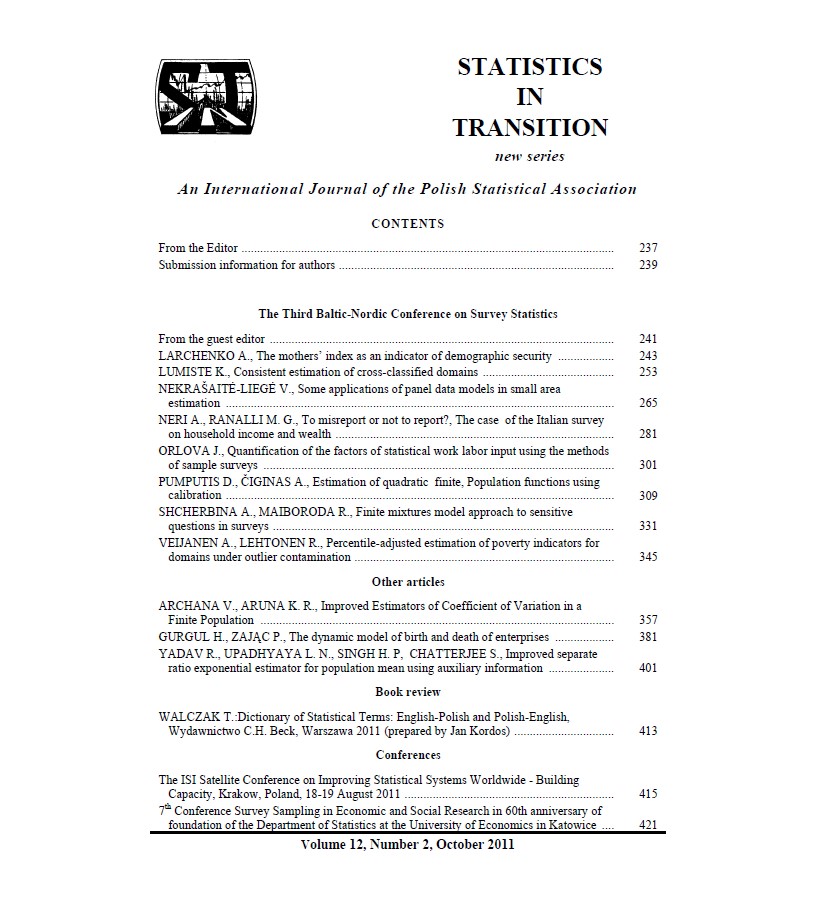ARTICLE
ABSTRACT
Traditional estimation of poverty and inequality indicators, such as the Gini coefficient, for regions does not currently use auxiliary information or models fitted to income survey data. A predictor-type estimator constructed from ordinary mixed model predictions is not necessarily useful, as the predictions have too small spread for estimation of income statistics. Ordinary bias corrections are aimed at correcting the expectation of predictions, but poverty indicators would not be affected at all by a correction involving multiplication of predictions. We need a method improving the shape of the distribution of predictions, as poverty indicators describe differences of income between people. We therefore introduce a transformation bringing the percentiles of transformed predictions closer to the percentiles of sample values. The experiments show that the transformation results in smaller MSE of a predictor. If unit-level data from population are not available, the marginal domain frequencies of qualitative auxiliary variables can be successfully incorporated into a new calibration-based predictor-type estimator. The results are based on design-based simulation experiments where we use a population generated from an EU-wide income survey. The study is a part of the AMELI project funded by the European Union under the Seventh Framework Programme for research and technological development (FP7).
KEYWORDS
small area estimation; poverty indicator; income data; bias correction; auxiliary information; mixed model; prediction
REFERENCES
ALFONS, A., TEMPL, M., FILZMOSER, P., KRAFT, S., HULLIGER, B, KOLB, J.-P. and MUNNICH, R., 2011. Report on outcome of the simulation study. (Deliverable 6.2 of WP6) [online] Trier: Project AMELI. Available at:
CHAMBERS, R. L. and DORFMAN, A. H., 2003. Transformed variables in survey sampling, Working paper M03/21, Southampton Statistical Sciences Research Institute.
CHAMBERS, R. and TZAVIDIS, N., 2006. M-quantile models for small area estimation. Biometrika, 93, pp. 255-268.
CHANDRA, H. and CHAMBERS, R., 2011. Small area estimation under transformation to linearity. Survey Methodology, 37, pp. 39-51.
CLEMENCEAU, A., J., MUSEUX M. and BAUER, M., 2006. EU - SILC (Community statistics on Income and Living Conditions): issues and challenges. [online]. Available at: http://www.stat.fi/eusilc/clemenceau_museux_bauer_rev2.pdf .
European Commission (EUROSTAT Working Group statistics on income, poverty and social exclusion), 2003. Laeken indicators. Detailed calculation methodology (DOC. E2/IPSE/2003). Luxembourg.
FABRIZI, E., FERRANTE, M. R. and PACEI, S., 2007. Comparing alternative distributional assumptions in mixed models used for small area estimation of income parameters. Statistics in Transition, 8, pp. 423-439.
JIANG, J. and LAHIRI, P., 2006. Mixed model prediction and small area estimation. Sociedad de Estadistica e Investigacion Operative Test, 15, pp. 1-96.
KARLBERG, F., 2000. Survey estimation for highly skewed populations in the presence of zeroes. Journal of Official Statistics, 16, pp. 229-241.
LEHTONEN, R. and VEIJANEN, A., 2009. Design-based methods of estimation for domains and small areas. In: C. R. Rao and Pfeffermann, D., eds. Handbook of statistics, vol. 29(B). Sample surveys: theory, methods and inference, pp. 219-249. Oxford: Elsevier.
MOLINA, I. and RAO, J. N. K., 2010. Small area estimation of poverty indicators. The Canadian Journal of Statistics, 38, pp. 369-385.
RAO, J. N. K., 2003. Small area estimation. New York: John Wiley & Sons.
SINGH, A. C. and MOHL, C. A., 1996. Understanding calibration estimators in survey sampling. Survey Methodology, 22, pp. 107-115.
SÄRNDAL, C.-E., 2007. The calibration approach in survey theory and practice. Survey Methodology, 33, pp. 99-119.
SÄRNDAL, C.-E., SWENSSON, B. and WRETMAN, J., 1992. Model assisted survey sampling. New York: Springer-Verlag.
YOU, Y. and RAO, J. N. K., 2002. A Pseudo-Empirical Best Linear Unbiased Prediction Approach to Small Area Estimation Using Survey Weights. The Canadian Journal of Statistics, 30, pp. 431-439.
ZASLAVSKY, A. M. and SCHIRM, A. L., 2002. Interactions between survey estimates and federal funding formulas. Journal of Official Statistics, 18, pp. 371-391.
